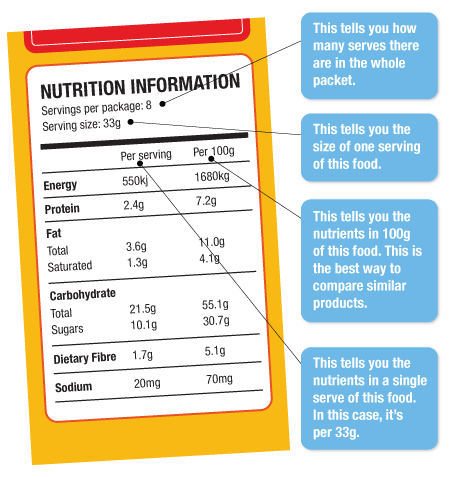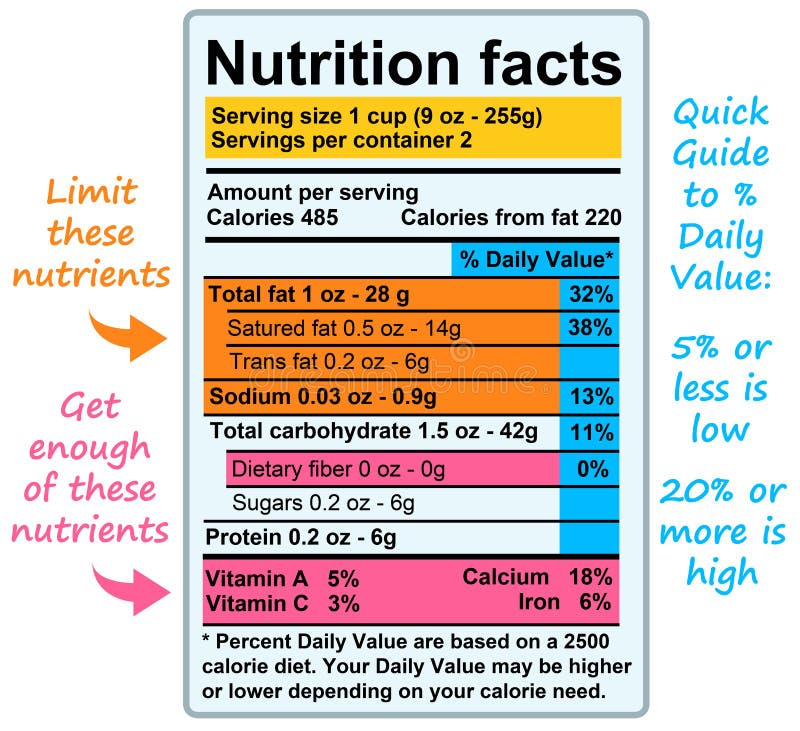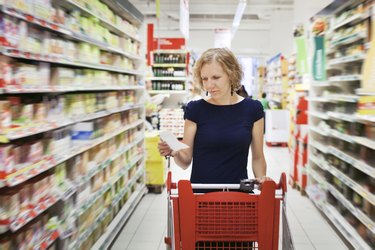41 nutrition labels list the energy content of food in
Nutrition Labels 101: What's Required? What's Optional? Total carbohydrates is a required listing unless there is less than 1 gram, at which point it can be expressed as "contains less than 1 gram," or if less than 0.5 grams per serving, it can be expressed as zero. Sugars are the sneaky nutrient found naturally in many "healthy" foods, including fruit and milk. Nutrition Labels Flashcards | Quizlet Nutrition Label Required on most packaged food in many countries Calories The amount of energy a food has. Total Fat The total amount of Saturated, unsaturated, and trans in each serving. Serving Size The amount you should eat for one serving. Servings per container The amount of servings in the food item. Percent of Daily Value
How Do You Know Your Food's Nutrition Facts Label Is Accurate? The short answer. Manufacturers often confirm their nutrition numbers by matching their products as closely as possible to NIST's food reference materials, which contain precisely measured quantities of nutrients. NIST's measurements are accurate to within 2% to 5% for nutrient elements (such as sodium, calcium and potassium ...
Nutrition labels list the energy content of food in
Nutrient food labels Flashcards | Quizlet Start studying Nutrient food labels. Learn vocabulary, terms, and more with flashcards, games, and other study tools. Home Browse. ... •Total food energy; food energy from fat •Total fat; saturated fat; trans fat; cholesterol ... Nutrition 2.1 Food Labels. 42 terms. Diana_Lopez0920. health claims and food labels. 50 terms. sydneyfinder. Nutrition labelling | Food Standards Agency The repeated information may be provided in the following formats: per 100g/ml only per 100g/ml and per portion on a per portion basis only Energy must always be indicated per 100g/ml as a minimum.... Food labels & nutritional information | Raising Children Network All foods have to list seven food components on their nutritional information panels - energy (kilojoules), protein, total fat, saturated fat, total carbohydrates, sugars and sodium. Manufacturers might decide to include other nutrients too, including fibre and calcium.
Nutrition labels list the energy content of food in. How to Calculate Energy From Foods - LIVESTRONG.COM Step 1. Multiply grams of carbohydrate in the food by 4 calories per gram. A calorie is a unit of how much energy is in a given amount of food, also called a kcal. Regardless of whether the carbohydrate in food is sugar or starch, all carbohydrates provide the body with 4 calories/gram, explains Dr. Lauralee Sherwood in her book "Human Physiology." Food labels: a guide to reading nutrition labels - MyDr.com.au A food making a 'diet' claim must meet some criteria regarding the content of nutrients of public health significance (saturated fat, sugars and sodium) and must either have no more than 80 kJ/100 mL (for liquid foods) or 160 kJ/100 g (for solid foods) or must have at least 40% fewer kilojoules than the same quantity of a reference food. Food Labels | CDC If you eat the whole thing, you are eating 8 times the amount of calories, carbs, fat, etc., shown on the label. Total Carbohydrate shows you types of carbs in the food, including sugar and fiber. Choose foods with more fiber, vitamins, and minerals. Choose foods with lower calories, saturated fat, sodium, and added sugars. Food Labels: Carbohydrates | Home & Garden Information Center According to nutrition experts, carbohydrates should provide 45-65% of your total daily calories. That means carbohydrates should supply 900 calories or more in a 2,000-calorie-a-day diet. Facts on Food Labels. Food labels contain clues to a food's carbohydrate content, including the amount per serving.
Nutrition facts label - Wikipedia In 2011 the Chinese Ministry of Health released the National Food Safety Standard for Nutrition Labeling of Prepackaged Foods (GB 28050-2011). The core nutrients that must be on a label are: protein, fat, carbohydrate and sodium. Energy is noted in kJ. And all values must be per 100g/100ml. An example of a Chinese nutrition facts label Food Labels | Nutrition.gov What's New with the Nutrition Facts Label. HHS, Food and Drug Administration. The U.S. Food and Drug Administration (FDA) has updated the Nutrition Facts label on packaged foods and beverages with a fresh design that will make it easier for you to make informed food choices that contribute to lifelong healthy eating habits. What's in a Name? Nutrition information panels - Food Standards Protein, fat, carbohydrate, dietary fibre and alcohol all provide energy (kilojoules). Protein Protein is essential for good health and is particularly important for children. Generally, people in developed countries eat enough protein to meet their requirements. Meat, poultry, fish, eggs, milk and cheese are animal sources of protein. What are Nutrient Content Claims on food labels? - Nutritionist Pro™ Nutrient Content Claims on Food Panels List energy, fat, carbohydrates, protein, and sodium. The nutritional information panels are a better guide than advertising. If the product contains food-inducing allergens, the label must say so. Some of the healthiest foods don't have labels, including fresh fruit and vegetables, and fish.
Nutritional Values For Common Foods And Products Highest caloric density foods Top Foods by Vitamin Vitamin A Thiamin Riboflavin Niacin Pantothenic acid Vitamin B6 Vitamin B12 Folate Vitamin C Vitamin D Vitamin E Vitamin K1 Betaine Choline Top Foods by Mineral Calcium, Ca Copper, Cu Fluoride, F Iron, Fe Magnesium, Mg Manganese, Mn Phosphorus, P Potassium, K Selenium, Se Sodium, Na Zinc, Zn Understanding Food Labels | The Nutrition Source | Harvard T.H. Chan ... The Nutrition Facts label is overseen by the U.S. Food and Drug Administration (FDA) and was first mandated under the Nutrition Labeling and Education Act of 1990 to help consumers make quick, informed food choices. It has undergone revisions, with the latest update released in 2016. Changes are generally based on updated scientific information and... Nutrition labels: Finding out about the food you eat All information on the nutrition label is based on a specific amount of food called the serving size. When you compare products, ensure that the serving sizes are the same. When comparing foods, use percent daily values (% DV) to find out if a food has a little or a lot of a nutrient. Choose foods with lower amounts of total fat, saturated fat ... How To Read Food and Beverage Labels - National Institute on Aging Or you can call the U.S. Department of Agriculture's Food and Nutrition Information Center at 301-504-5414. Understanding percent Daily Value (% DV) The percent Daily Value (% DV) tells how much a nutrient in a serving of the food or beverage contributes to a total daily 2,000-calorie diet.
Calories on the New Nutrition Facts Label | FDA Feb 25, 2022 · One package of food may contain more than one serving, so, if you eat two servings you would be getting two times the calories shown on the label. For example, if you ate one serving of the food...
How to Read the Nutrition Facts Label on Packaged Foods Sodium. Many people get far too much salt, or sodium. Most of it is in packaged foods and restaurant items. Limit salt to 2,300 milligrams (about 1 teaspoon) daily. If you have high blood pressure ...
The energy content of food - Diet - GCSE Biology (Single Science ... energy transferred to water = 10 × 4.2 × 20 = 840 J. energy content of food = 840 ÷ 0.5 = 1680 J/g. Fair testing. When comparing different foods, it is important to carry out a fair test ...
How to understand food labels - Eat For Health The Nutrition Information Panel on a food label offers the simplest and easiest way to choose foods with less saturated fat, salt (sodium), added sugars and kilojoules, and more fibre. It can also be used to decide how large one serve of a food group choice or discretionary food would be and whether it's worth the kilojoules.
How to calculate the Energy available from foods To calculate the energy available from a food, multiply the number of grams of carbohydrate, protein, and fat by 4,4, and 9, respectively. Then add the results together. For example, 1 slice of bread with a tablespoon of peanut butter on it contains 16 grams carbohydrate, 7 grams protein, and 9 grams fat : 16g carbohydrate x 4 kcal/g = 64 kca l
Energy (kJ) Content of Foods - Whole Food Catalog You can find out about Energy (kJ) Content of Foods. In this website, nutritional content included in 1878 kinds of foods are introduced by using graphs etc. Energy (kJ) Content of Foods. 472 kj (per 12 g edible portion) Lard. 393 kj (per 10 g edible portion) Beef tallow. 462 kj (per 12 g edible portion) Shortening.
Food labels - NHS Nutrition labels are often displayed as a panel or grid on the back or side of packaging. This type of label includes information on energy (kJ/kcal), fat, saturates (saturated fat), carbohydrate, sugars, protein and salt. It may also provide additional information on certain nutrients, such as fibre.
Understanding food labels: portions, energy | Health24 - News24 Jul 21, 2012 · However, many manufacturers still list the energy content of foods in calories (cal) or use both kJ and calories. Confusion arises when the label expresses the energy content in kcal (or kilo-calories). Energy contained in food is always expressed in kcal, but most manufacturers forget to use the 'k' in front of the 'cal' in the abbreviation.





Post a Comment for "41 nutrition labels list the energy content of food in"